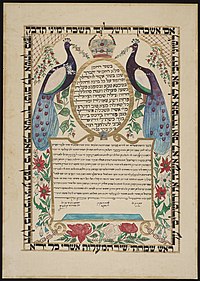
Back الزواج في اليهودية Arabic الزواج فى اليهوديه ARZ Casament jueu Catalan Židovská svatba Czech Juda geedziĝo Esperanto عروسی یهودی Persian Mariage dans le judaïsme French חופה וקידושין HE Zsidó esküvői hagyományok Hungarian Հրեական հարսանիք Armenian



A Jewish wedding is a wedding ceremony that follows Jewish laws and traditions. While wedding ceremonies vary, common features of a Jewish wedding include a ketubah (marriage contract) that is signed by two witnesses, a chuppah or huppah (wedding canopy), a ring owned by the groom that is given to the bride under the canopy, and the breaking of a glass.
Technically, the Jewish wedding process has two distinct stages.[1] The first, kiddushin (Hebrew for "betrothal"; sanctification or dedication, also called erusin) and nissuin (marriage), is when the couple start their life together. It is at the first stage (kiddushin) when the woman becomes prohibited to all other men, requiring a get (religious divorce) to dissolve it, while the second stage permits the couple to each other. The ceremony that accomplishes nissuin is also known as chuppah.[2]
Today, erusin/kiddushin occurs when the groom gives the bride a ring or other object of value with the intent of creating a marriage. There are differing opinions as to which part of the ceremony constitutes nissuin/chuppah, such as standing under the canopy and being alone together in a room (yichud).[2] Erusin/kiddushin has evolved from a period in which the man was to prepare financially to marry his wife into becoming the first half of the wedding ceremony. While historically these two events could take place as much as a year apart,[3] they are now commonly combined into one ceremony.[2]
- ^
 This article incorporates text from a publication now in the public domain: Singer, Isidore; et al., eds. (1901–1906). "marriage ceremonies". The Jewish Encyclopedia. New York: Funk & Wagnalls.
This article incorporates text from a publication now in the public domain: Singer, Isidore; et al., eds. (1901–1906). "marriage ceremonies". The Jewish Encyclopedia. New York: Funk & Wagnalls.
- ^ a b c Made in Heaven, A Jewish Wedding Guide by Rabbi Aryeh Kaplan, Moznaim Publishing Company, New York / Jerusalem, 1983, Chapter 18
- ^ Talmud Bavli, Ketubot, page 2